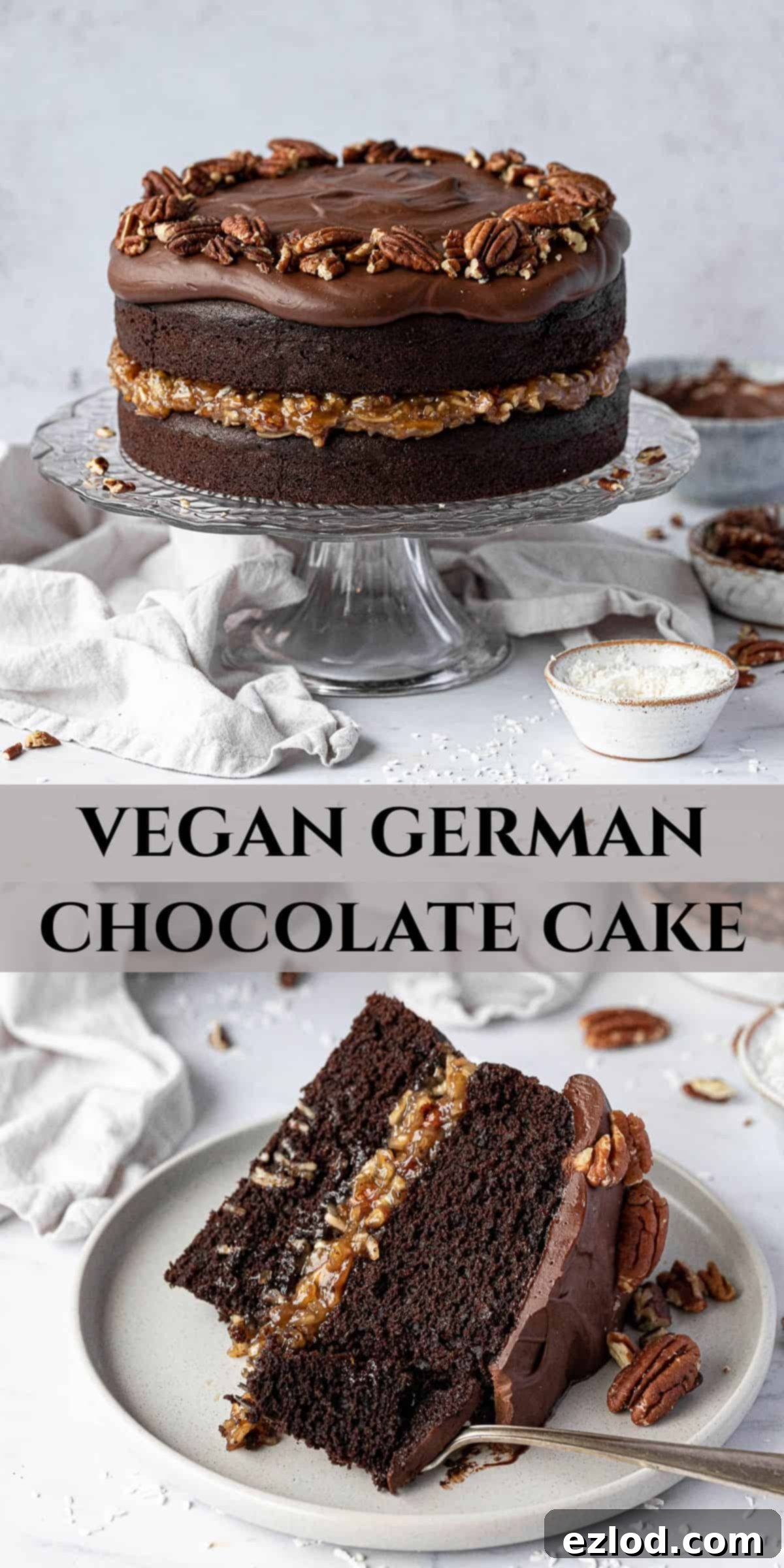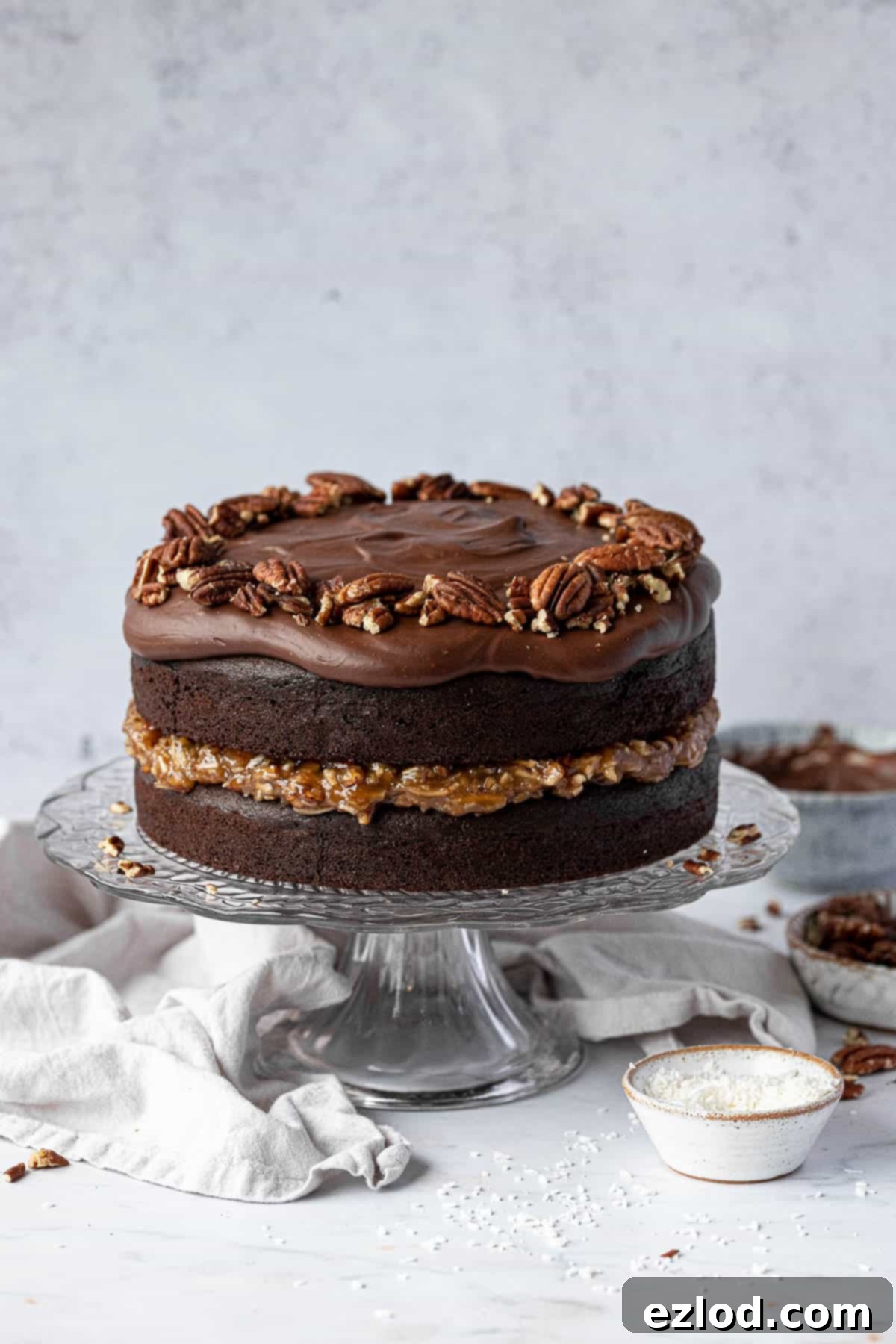Decadent Vegan German Chocolate Cake: Moist Layers, Creamy Coconut-Pecan Filling & Rich Ganache
Prepare to be amazed by this incredible **Vegan German Chocolate Cake**, a truly show-stopping dessert that promises layers of moist, fluffy chocolate cake, generously filled with a sweet, rich coconut pecan caramel custard, and crowned with a luscious dark chocolate ganache. This cake isn’t just a treat for the taste buds; it’s a celebration in every slice, perfect for birthdays, special occasions, or simply when you crave an indulgent, plant-based dessert.
Crafting this delicious cake is surprisingly straightforward, making it an accessible project for bakers of all skill levels. We’ve taken the classic German Chocolate Cake and transformed it into an utterly irresistible vegan masterpiece, ensuring no compromise on flavour or texture. Each component is designed to complement the others, creating a harmonious balance of deep chocolate, sweet caramel, crunchy pecans, and tropical coconut.
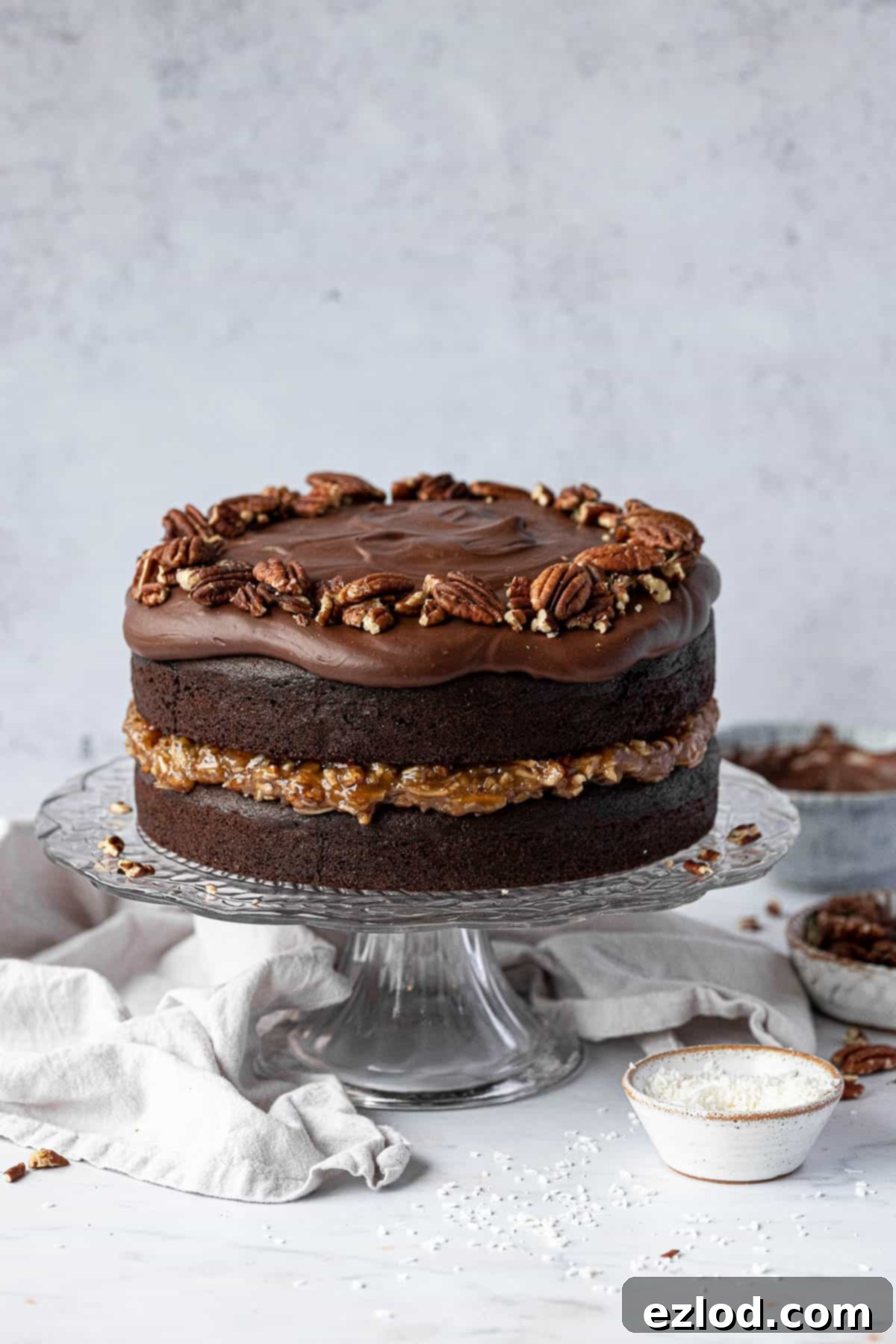
What Is German Chocolate Cake? A Culinary History
Despite its name, **German Chocolate Cake** does not originate from Germany. Its intriguing name comes from Samuel German, an American chocolate maker who, in 1852, developed a dark baking chocolate bar for the Baker’s Chocolate Company. This specific type of chocolate, originally called “Baker’s German’s Sweet Chocolate,” was later featured in a Dallas Morning News recipe in 1957, which popularized the cake we know and love today. Over time, the apostrophe “s” was dropped, leading to the common misconception about its origins.
Traditionally, German Chocolate Cake features distinct layers of light, sweet chocolate cake. What truly sets it apart, however, is its iconic filling and topping: a creamy caramel custard generously mixed with shredded coconut and chopped pecans. Some variations also include a rich chocolate frosting or ganache coating the sides or top. Our vegan rendition captures all these beloved elements, delivering that classic taste and texture without any animal products. We focus on a moist chocolate cake base, a rich, dairy-free coconut pecan filling, and a decadent dark chocolate ganache to provide the perfect contrast and finish.
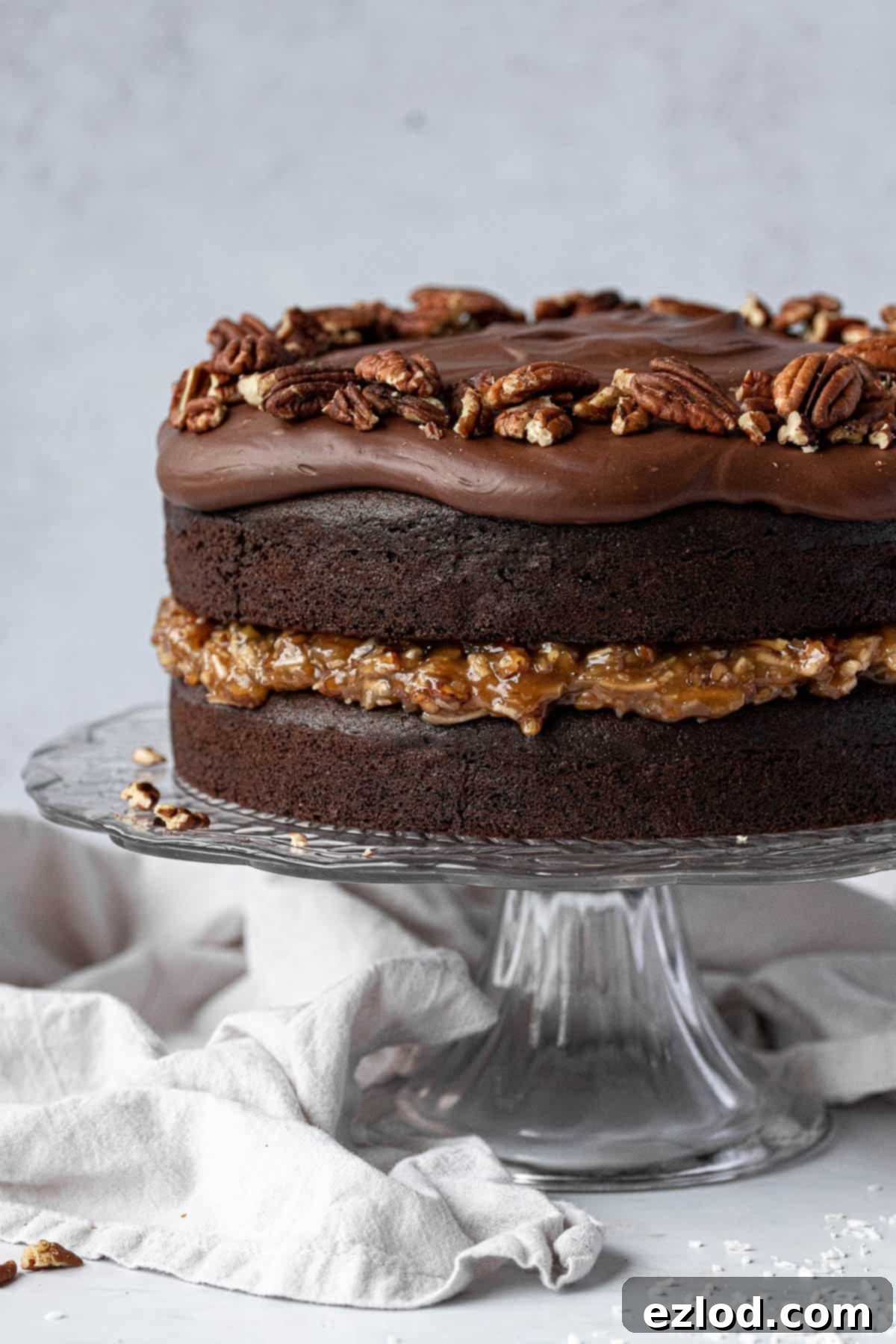
Essential Ingredients for Your Vegan German Chocolate Cake
Creating this magnificent cake requires a selection of quality ingredients for each component: the moist chocolate cake layers, the luscious coconut pecan filling, and the smooth chocolate ganache. Here’s a detailed look at what you’ll need and why each ingredient plays a crucial role:
For The Cake:
- Plain Flour (All-Purpose Flour): This is the foundation of our cake structure. Regular plain flour provides a light and tender crumb. While I haven’t specifically tested a gluten-free version, a good quality gluten-free flour blend, ideally containing xanthan gum (or adding ¼ tsp if it doesn’t), should work as a substitute, though the texture might vary slightly. Avoid using wholemeal flour as it tends to make cakes too dense.
- Cocoa Powder: For a deep, rich chocolate flavor and dark color, I recommend using Dutch-processed cocoa powder. This type of cocoa has been treated to reduce its acidity, resulting in a smoother, less bitter chocolate taste. In the UK, “regular” cocoa powder is typically Dutch-processed.
- Sugar: Caster sugar is my go-to for its fine texture, which dissolves easily and contributes to a smooth batter. Granulated sugar, light brown soft sugar, or even coconut sugar can also be used, each imparting a slightly different nuance to the sweetness and moisture of the cake.
- Baking Powder and Baking Soda: These two leavening agents work in tandem to give the cake its impressive rise and wonderfully light, soft texture. Baking soda reacts with the acidic vinegar and cocoa powder to create carbon dioxide bubbles, while baking powder provides additional lift, ensuring a consistently airy crumb.
- Non-Dairy Milk: Any unsweetened non-dairy milk will work, but soy milk is highly recommended due to its higher protein content, which can contribute to a more stable emulsion and a richer texture in vegan baking. Almond or oat milk are also good alternatives.
- Neutral Oil: A neutral-flavored oil like sunflower, canola, or a mild olive oil is crucial. It adds moisture without imparting a strong flavor, ensuring the chocolate is the star. I advise against using coconut oil here, unless it’s your only option, as its solidification at room temperature can alter the cake’s texture.
- Vinegar: Apple cider vinegar or white wine vinegar are essential activators for the baking soda, contributing to the cake’s rise. The acid reacts to create air bubbles, resulting in a fluffy cake. Lemon juice is also a suitable substitute if you don’t have vinegar.
- Vanilla Extract: High-quality vanilla extract enhances the overall flavor profile, complementing the chocolate beautifully. While vanilla essence can be used, extract offers a more authentic and potent flavor. Vanilla bean paste is another excellent, more intense option.
- Espresso Powder (Optional): A small amount of instant espresso powder might seem unusual, but it’s a secret weapon for intensifying and deepening the chocolate flavor without making the cake taste like coffee. It simply brings out the best in the cocoa.
- Salt: A pinch of salt is vital for balancing the sweetness and enhancing all the other flavors in the cake, making them more vibrant.
For The Filling:
- Coconut: Traditionally, dried shredded coconut is used. However, it can sometimes be difficult to find specific types in all regions. I’ve had great success with defrosted frozen shredded fresh coconut (found in some supermarkets like Morrisons in the UK), but unsweetened desiccated coconut or dried coconut flakes also work beautifully, providing that essential tropical note and chewy texture.
- Pecans: Pecans are the traditional nut for German Chocolate Cake, offering a buttery, slightly sweet crunch. I love to toast them lightly before adding them to the filling to bring out their full flavor. Feel free to decorate the cake with extra pecans for an elegant finish. If pecans aren’t available or preferred, walnuts make an excellent alternative.
- Cornflour (Cornstarch): In traditional recipes, egg yolks are used to thicken the custard filling. For our vegan version, cornflour acts as a fantastic plant-based thickener, creating a smooth, rich, and perfectly set caramel custard.
- Full-Fat Coconut Milk: Replacing traditional evaporated milk, full-fat coconut milk provides the necessary creaminess and body for the filling, along with a subtle, complementary coconut flavor. If you can find evaporated coconut milk (like from Nature’s Charm), that would also work wonderfully for an even closer texture to the original.
- Vegan Block Butter: For the best results and a filling that sets properly, I highly recommend using a block-style vegan butter (such as Naturli Vegan Block or Flora Plant Butter) rather than a spreadable tub variety. Block butter has a higher fat content and firmer texture, crucial for the filling’s consistency.
- Light Brown Soft Sugar: This sugar is ideal for the filling, contributing a rich caramel flavor and a beautiful golden hue. Dark brown soft sugar can also be used for a more intense molasses flavor, or coconut sugar for a slightly different sweet profile.
For The Ganache:
- Dark Chocolate: Use a high-quality dark chocolate with a cocoa percentage of no more than 70%. Anything higher can make the ganache more prone to splitting or becoming too firm. Finely chopping the chocolate ensures it melts smoothly and evenly.
- Full-Fat Coconut Milk or Vegan Double Cream Alternative: For a rich and pourable ganache, full-fat coconut milk or a dedicated vegan double cream alternative (like Elmlea Plant Double Cream) works perfectly. The fat content is key for achieving the right consistency.
- Maple Syrup: A touch of maple syrup is added to slightly sweeten the ganache and give it a beautiful, glossy sheen. Golden syrup or agave nectar can be used as alternatives.
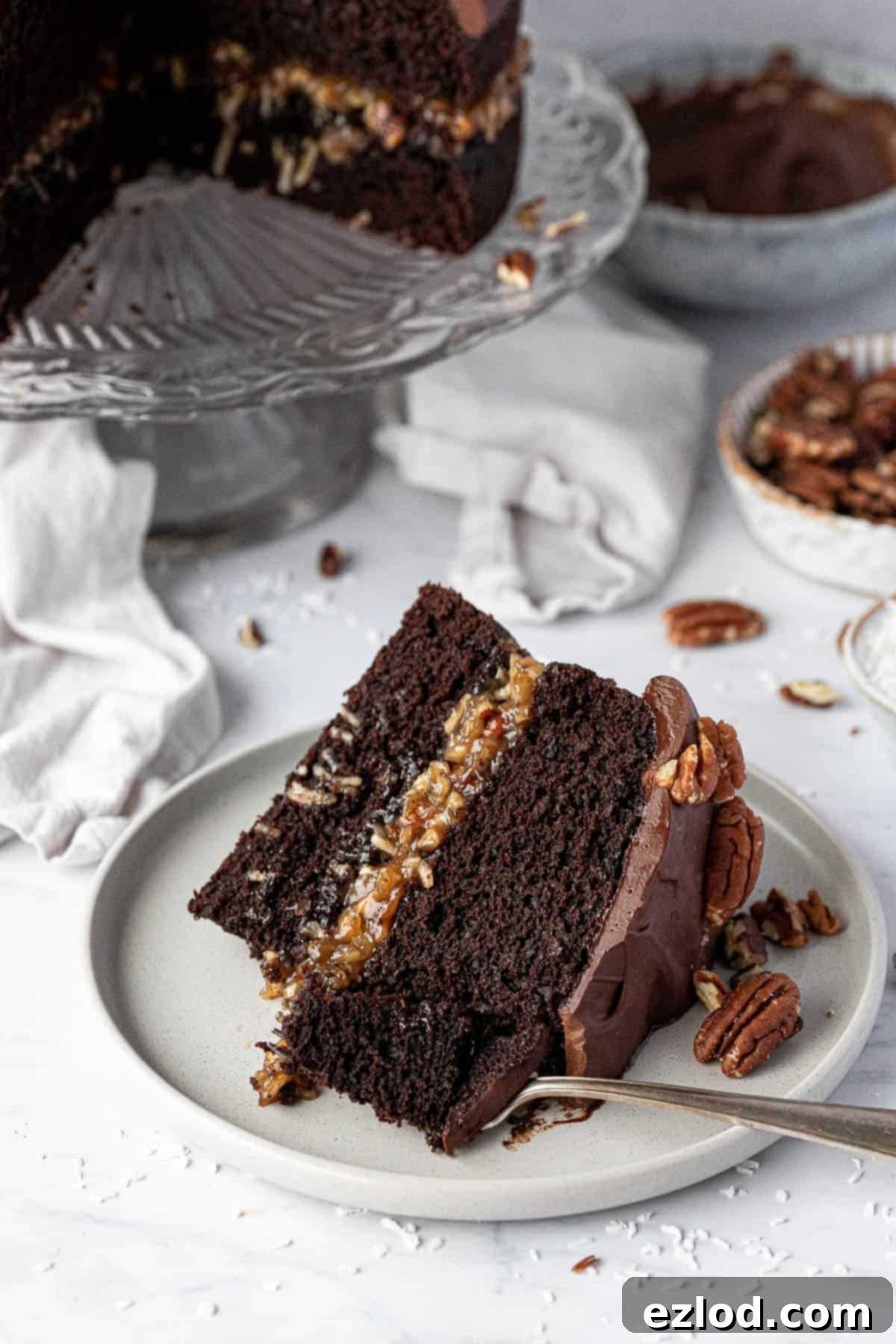
How To Make Your Vegan German Chocolate Cake: Step-by-Step Guide
(For precise measurements and detailed instructions, please refer to the recipe card located at the bottom of this page.)
Making this impressive vegan German Chocolate Cake involves three main stages: preparing the chocolate cake layers, crafting the luscious coconut pecan filling, and finally, making the rich chocolate ganache and assembling the cake. Follow these steps for a perfect result:
1. Prepare the Cake Layers:
Begin by preheating your oven to 180°C/160°C fan/350°F/gas mark 4. Lightly grease two 20cm (8-inch) round cake tins and line their bottoms with baking parchment. This ensures your beautiful cake layers release easily.
In a large jug, whisk together all the wet ingredients for the cake: the unsweetened non-dairy milk, vinegar, sugar, oil, and vanilla extract. Ensure they are well combined. In a separate, larger bowl, sift together the dry ingredients: plain flour, cocoa powder, baking powder, bicarbonate of soda, instant espresso powder (if using), and salt. Sifting helps prevent lumps and ensures an even distribution of leavening agents.
Gradually pour the wet mixture into the dry ingredients, whisking gently until the batter is just smooth. It’s crucial not to over-mix the batter, as this can develop the gluten too much, leading to a tough cake. A hand balloon whisk is ideal for this step, preventing over-agitation.

Divide the batter evenly between your two prepared cake tins. For accuracy, I recommend using a kitchen scale to ensure equal distribution, which helps the cakes bake evenly. Smooth the tops and bake for approximately 30 minutes, or until a skewer inserted into the center comes out clean. The cakes should spring back lightly when touched.

Once baked, allow the cakes to cool in their tins for about 10 minutes before carefully inverting them onto a wire rack to cool completely. Cooling thoroughly is vital before assembling, otherwise, the filling will melt and slide off.
2. Prepare the Coconut Pecan Caramel Filling:
In a small bowl, place the cornflour and gradually whisk in a small amount of the full-fat coconut milk until you have a smooth slurry with no lumps. This prevents the cornflour from clumping when added to the hot mixture.
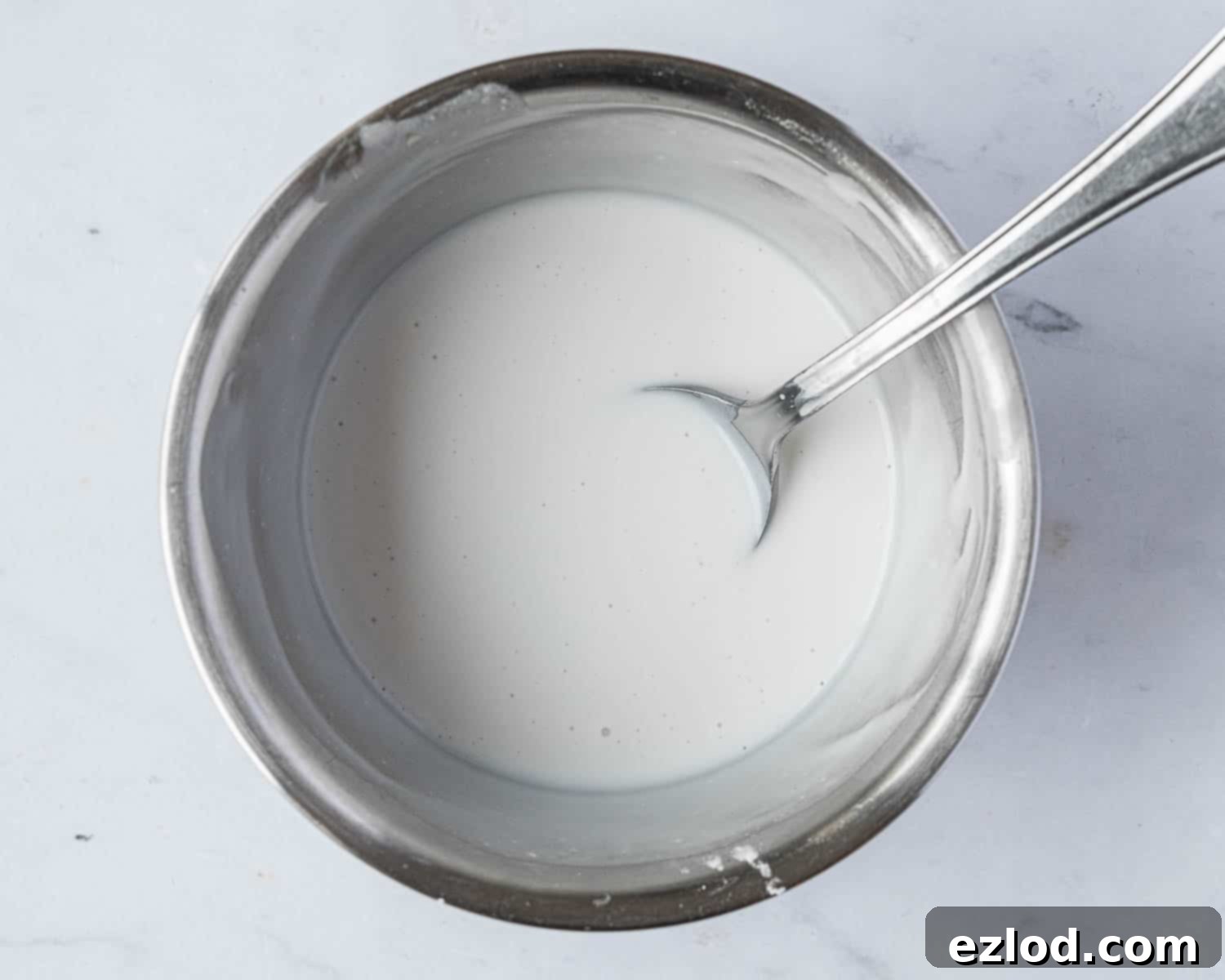
In a saucepan, gently melt the vegan block butter and light brown soft sugar together over low heat, stirring occasionally until the sugar has mostly dissolved. Then, whisk in your cornflour-coconut milk mixture. Increase the heat slightly and bring the mixture to a gentle simmer, whisking constantly. Continue whisking as it thickens into a rich, creamy caramel custard. This usually takes a few minutes.
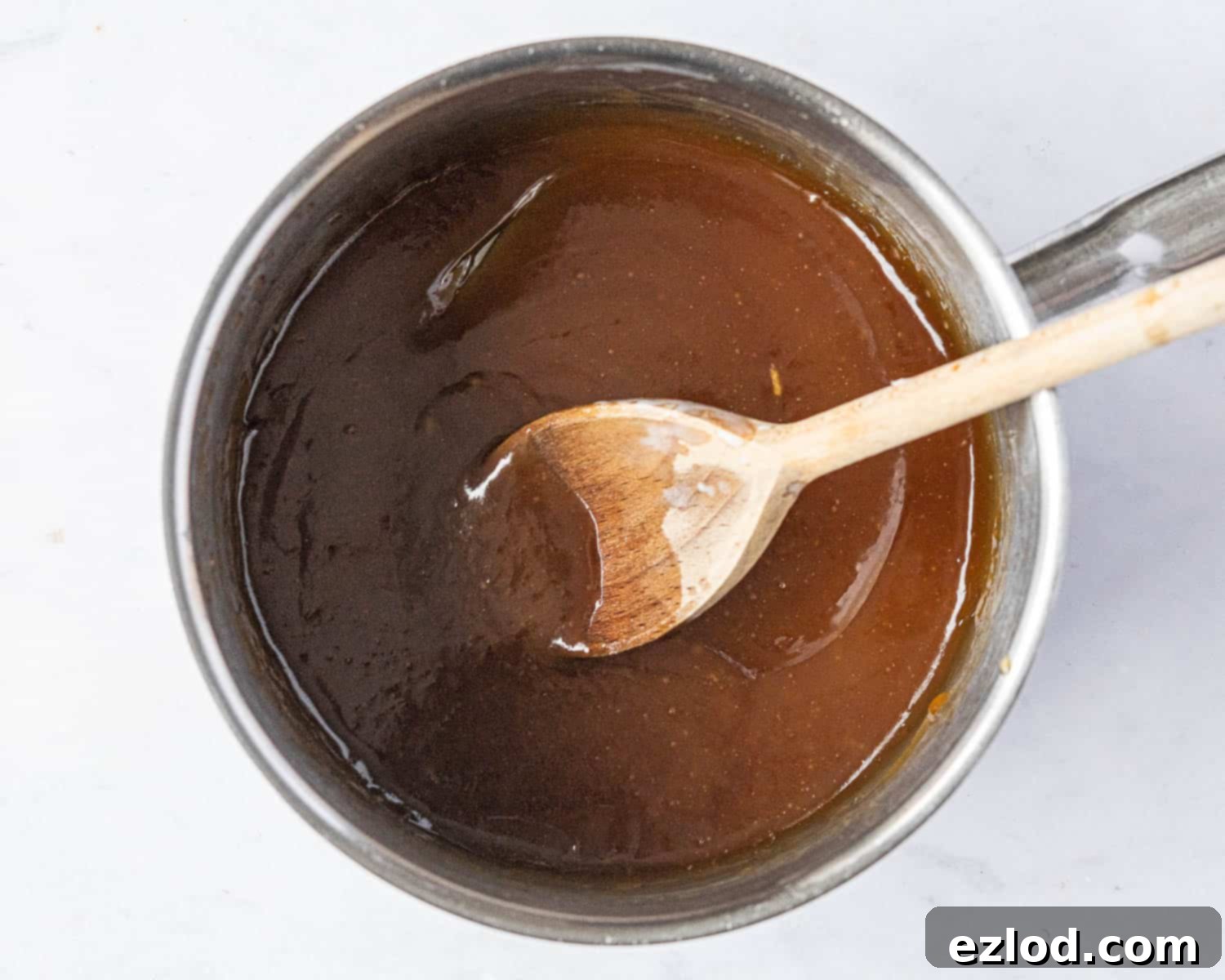
Remove the pan from the heat and stir in the toasted pecans (chopped), toasted shredded coconut, vanilla extract, and a pinch of salt. Mix well to combine all the delicious elements. Set the filling aside to cool completely; it will thicken further as it cools.
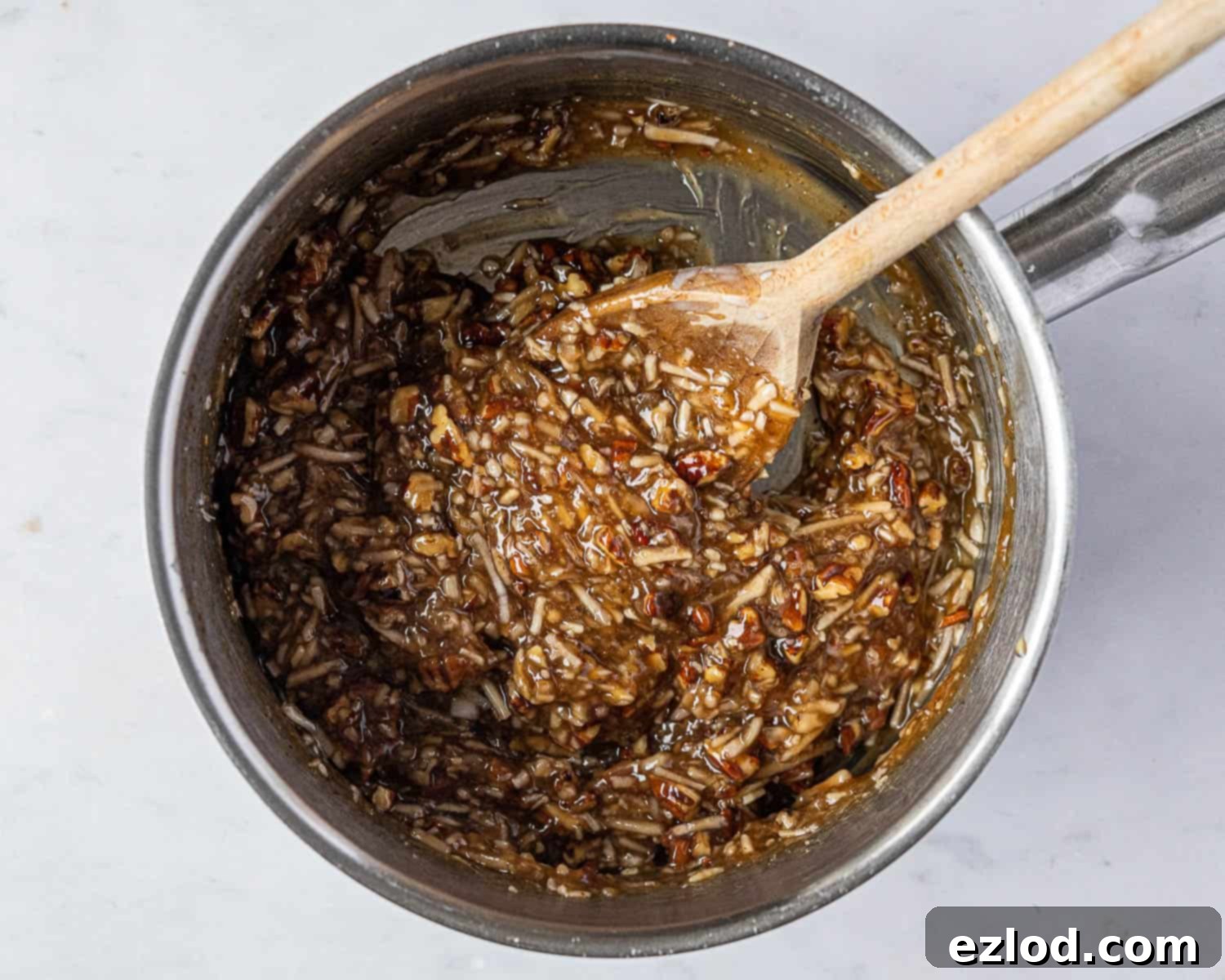
3. Prepare the Chocolate Ganache:
Finely chop your dark chocolate and place it in a heat-proof bowl. The finer the chop, the faster and more smoothly it will melt.
In a small saucepan, gently heat the full-fat coconut milk (or vegan double cream alternative) and maple syrup until it’s almost simmering. Do not let it come to a rolling boil. As soon as small bubbles start to form around the edges, remove it from the heat.
Pour the hot milk mixture over the finely chopped chocolate, ensuring all the chocolate is submerged. Let it sit undisturbed for five minutes. This allows the heat from the milk to slowly melt the chocolate.
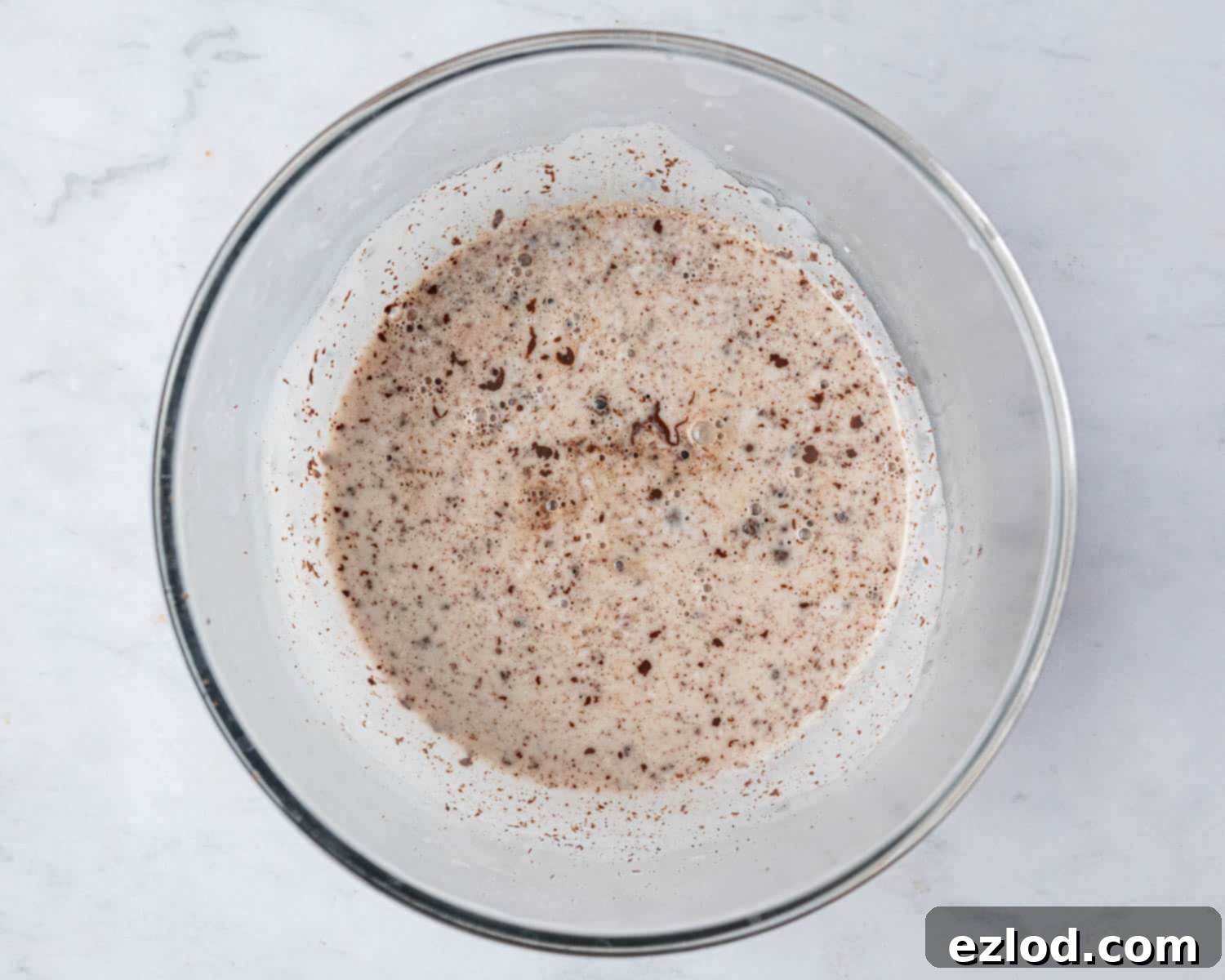
After five minutes, gently stir the mixture with a whisk or spatula until it becomes completely melted, smooth, and glossy. Be patient and stir slowly to prevent air bubbles. Set the ganache aside to cool and thicken to a spreadable consistency. If it becomes too firm, a quick burst in the microwave (10-15 seconds) with a stir can loosen it up. If it’s too thin, let it cool longer, or even pop it in the fridge for a few minutes, stirring every couple of minutes.
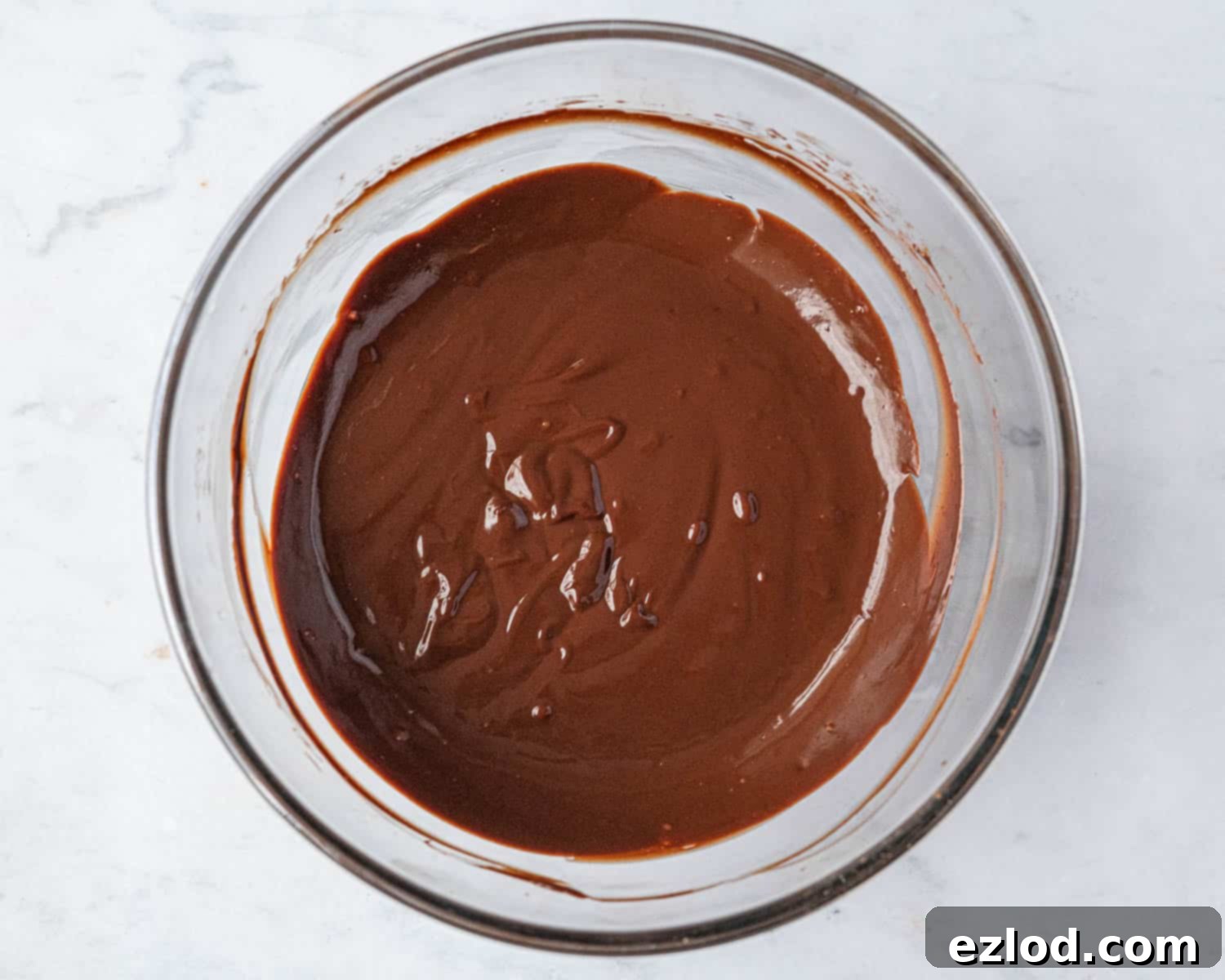
4. Assemble the Cake:
Once your cake layers are completely cool, use a cake wire or a sharp serrated knife to carefully trim the tops, leveling them for a neat and even cake structure.
Place one cake layer onto your chosen cake stand or serving plate. Spread all of the cooled coconut pecan caramel filling evenly over this layer, leaving a small border around the edge if you wish.
Carefully place the second cake layer on top, preferably upside-down, as the bottom is usually flatter. This creates a beautifully level top. Finally, spread the thickened chocolate ganache evenly over the top of the cake. For an extra flourish, decorate with additional chopped or whole pecans if desired. Your magnificent Vegan German Chocolate Cake is now ready to impress!
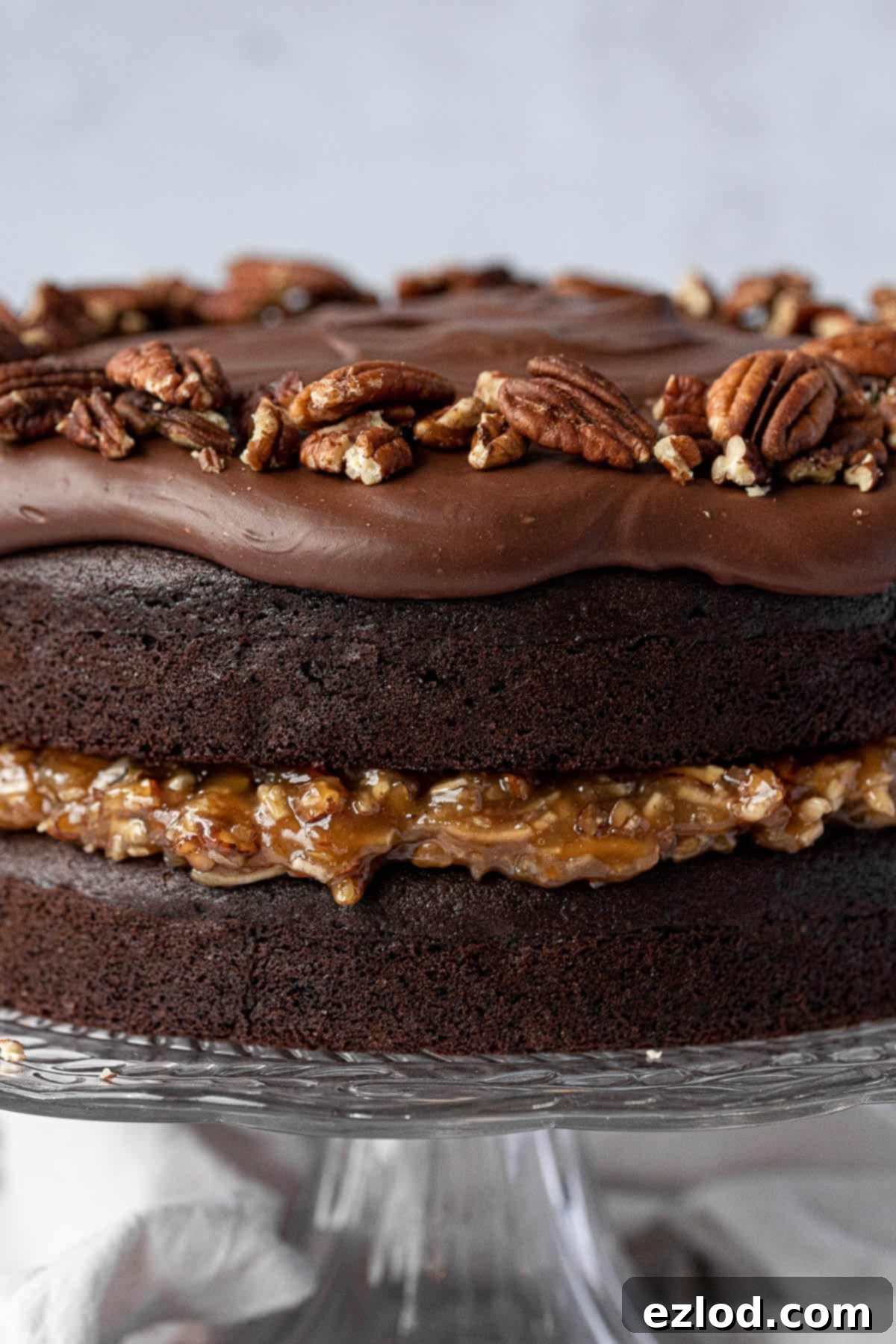
Top Tips for German Chocolate Cake Success
Achieving a perfect Vegan German Chocolate Cake is easier with a few insider tips:
- Embrace Metric Measurements: For all my baking recipes, I wholeheartedly recommend using metric measurements with a digital scale. Cups are an inherently inaccurate measuring system, leading to inconsistent results. A digital scale ensures precision, better consistency, and often less mess!
- Avoid Over-mixing: Once you combine the wet and dry cake ingredients, mix only until no dry lumps remain. Over-mixing develops gluten, which can result in a tough, rubbery cake. Hand-whisking is often preferable to electric mixers for this reason.
- Ensure Even Mixing: To prevent over-mixing when combining wet and dry ingredients, ensure both bowls (wet and dry) are thoroughly mixed independently first. This way, you only need minimal mixing once they’re combined.
- Customise Your Sweetness: I designed this recipe to have the coconut pecan caramel filling only between the layers, topped with ganache, for a balanced sweetness. If you prefer a sweeter, more traditional German Chocolate Cake that also has the filling on top, you can easily double the filling recipe.
- Coconut Variety: The recipe is versatile with coconut. While defrosted frozen shredded coconut offers a lovely texture, unsweetened desiccated coconut or dried coconut flakes are excellent, readily available alternatives.
- Nut Substitutions: While pecans are classic, feel free to use other nuts. Toasted walnuts are a fantastic alternative, offering a slightly different but equally delicious flavor profile.
- Toast Your Nuts and Coconut: This optional step makes a huge difference! Lightly toasting the pecans and coconut before adding them to the filling significantly enhances their flavor and aroma, adding an extra layer of depth to your cake.
- Patience with Cooling: Allow all components—especially the cake layers and the filling—to cool completely before assembly. Warm components will cause the cake to slide and the filling/ganache to melt.
How To Store Your Vegan German Chocolate Cake
Proper storage ensures your delicious cake stays fresh and enjoyable:
- Assembled Cake: The fully assembled cake can be stored in an airtight container at room temperature for up to two days. If your kitchen is warm, or during hot weather, it’s best to store the cake in the refrigerator to prevent the ganache and filling from becoming too soft.
- Cake Layers: You can bake the chocolate cake layers in advance. Once completely cooled, wrap them tightly in plastic wrap and then foil. They can be frozen for up to three months. Thaw them in the refrigerator overnight or at room temperature for a few hours before assembling.
- Filling: The coconut pecan caramel filling can also be made a day in advance. Store it in an airtight container in the refrigerator. Bring it to room temperature or gently warm it slightly (if it’s too firm) before spreading.
More Delicious Vegan Layer Cake Recipes:
- Vegan Chocolate Fudge Cake
- Vegan Carrot Cake
- Vegan Pumpkin Cake with Cinnamon Buttercream and Maple Pecans
- Vegan Banana Cake with Chocolate Peanut Butter Frosting
- Orange and Almond Cake with Chocolate Buttercream
- Coconut Layer Cake
- Vegan Victoria Sponge Cake
- Vegan Mulled Wine Chocolate Cake
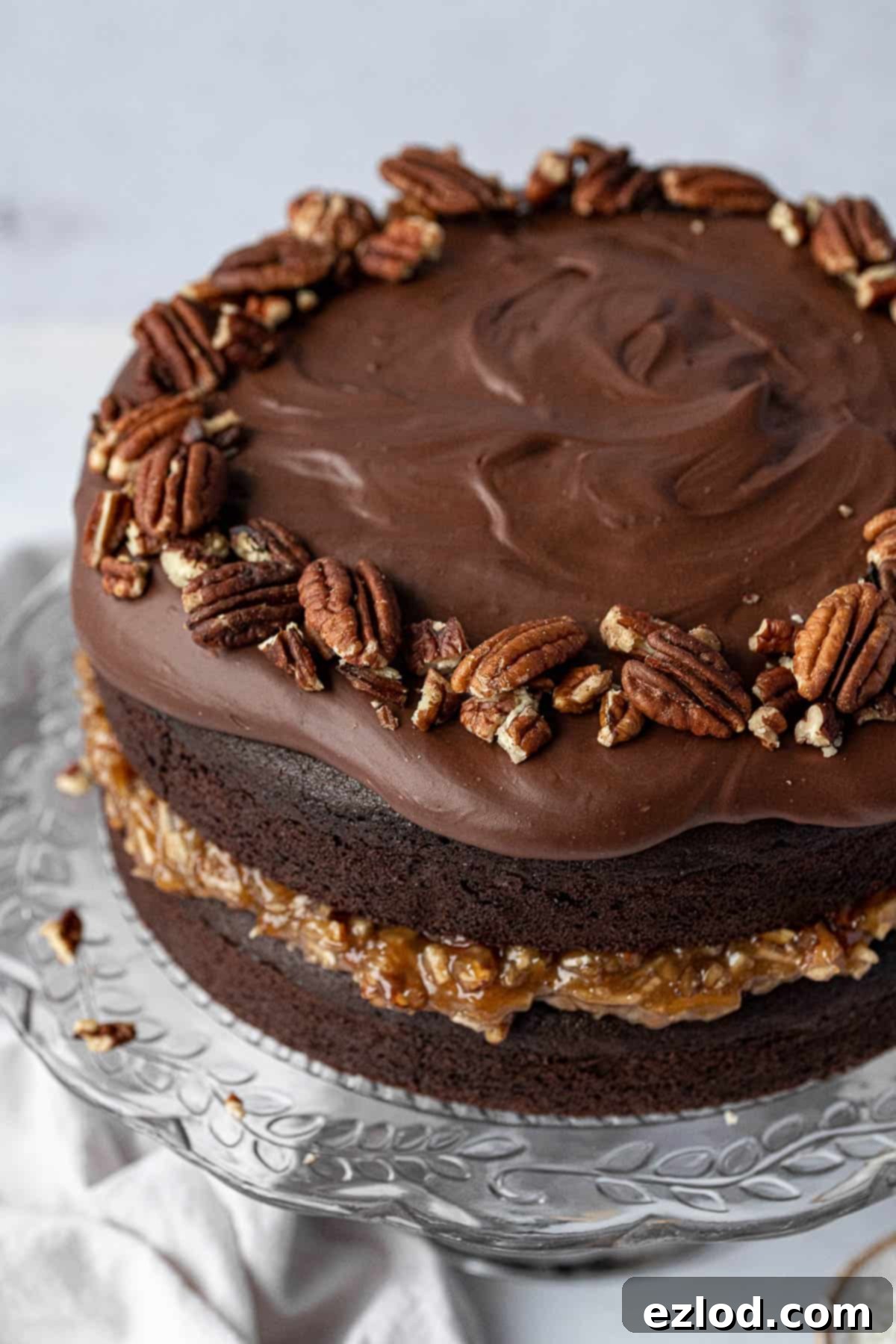
If you tried this incredible Vegan German Chocolate Cake recipe, please let me know how it went! Your feedback is invaluable. Don’t forget to rate it, leave a comment below, or tag @domestic_gothess on Instagram and hashtag it #domesticgothess to share your creation!
All images and content on Domestic Gothess are copyright protected. If you wish to share this recipe, please do so by using the provided share buttons. Please do not screenshot or post the recipe or content in full. Instead, kindly include a link directly to this post for the complete recipe. Thank you for your understanding and support!

Print
Vegan German Chocolate Cake
Ingredients
Cake:
- 400 ml (1 ½ cups + 2 Tbsp + 2 tsp) unsweetened non-dairy milk (I use soy)
- 160 ml (⅔ cup) neutral oil (I use sunflower)
- 2 teaspoons vinegar
- 280 g (1 + ¼ cups + 2 Tablespoons) caster sugar
- 2 teaspoons vanilla extract
- 260 g (2 cups + 2 Tbsp) plain (all-purpose) flour
- 90 g (⅔ cup + 1 Tbsp) cocoa powder
- 1 teaspoon baking powder
- 1 teaspoon bicarbonate of soda (baking soda)
- 1 teaspoon instant espresso powder
- ¼ teaspoon salt
Filling:
- 10 g (1 packed Tablespoon) cornflour (cornstarch)
- 120 ml (½ cup) full fat coconut milk
- 100 g (packed ½ cup) light brown soft sugar
- 60 g (¼ cup) vegan block butter (I use Naturli Vegan Block)
- ½ teaspoon vanilla extract
- 65 g (2 ⅓ oz) shredded coconut (or unsweetened desiccated coconut) toasted
- 65 g (2 ⅓ oz) pecans toasted and chopped
- pinch salt
Ganache:
- 150 g (5 ⅓ oz) dark chocolate (no more than 70% cocoa solids) finely chopped
- 150 ml (½ cup + 2 Tablespoons) full fat coconut milk or vegan double cream alternative (such as Elmlea)
- ½ Tablespoon maple syrup
- whole and chopped pecans for decoratring (optional)
Instructions
-
Preheat the oven to 180°C/160°C fan/350°F/gas mark 4. Grease two 20cm/8in round cake tins and line with baking parchment.
-
Whisk together the milk, vinegar, sugar, oil and vanilla extract in a large jug.
-
In a large bowl sift together the plain flour, cocoa powder, baking powder, bicarbonate of soda, espresso powder and salt.
-
Gradually whisk the wet ingredients into the dry until the batter is smooth. It is important not to over-mix it however or the cake can become tough, so I recommend using a hand balloon whisk rather than an electric mixer.
-
Divide the batter evenly between the prepared tins (I use a scale for accuracy) and spread it level. Bake the cakes for about 30 minutes until they are firm to the touch and a skewer inserted into the centre comes out clean.
-
Leave the cakes to cool in the tins for 10 minutes then carefully turn them out onto a wire rack and leave to cool completely.
-
To make the filling, place the cornflour in a bowl and gradually stir in the coconut milk, making sure that there are no lumps.
-
Melt the butter and sugar together gently in a pan then whisk in the cornflour mixture. Bring the mixture up to a simmer and whisk constantly until it thickens.
-
Stir in the toasted pecans and coconut, vanilla extract and a pinch of salt. Set aside to cool.
-
To make the ganache, finely chop the chocolate and place it in a heat-proof bowl.
-
Place the coconut milk and maple syrup in a pan and heat until it is almost simmering. Do not let it come to the boil. Pour the hot milk over the chopped chocolate, making sure that it is fully covered, and leave to sit for five minutes.
-
Stir gently until melted and smooth. Set aside until it thickens enough to spread. If you accidentally leave it for too long and it sets, you can gently re-warm it in short bursts in the microwave, stirring often.
-
To assemble the cake, trim the tops of the cake layers with a cake wire or a sharp serrated knife to level them. Place one layer on a cake stand or plate and spread over all of the filling.
-
Place the other cake layer on top, upside-down. Spread over the ganache and decorate with chopped pecans if you like.
Notes
- See post above for tips, details and step-by-step photos.
- All of my recipes are developed using grams, and as with all of my baking recipes I really do recommend using the metric measurements with a digital scale rather than the cup coversions. Cups are a wildly inaccurate measuring system and you will get far better, more consistent results using a scale, not to mention that it is also easier and less messy than cups!
